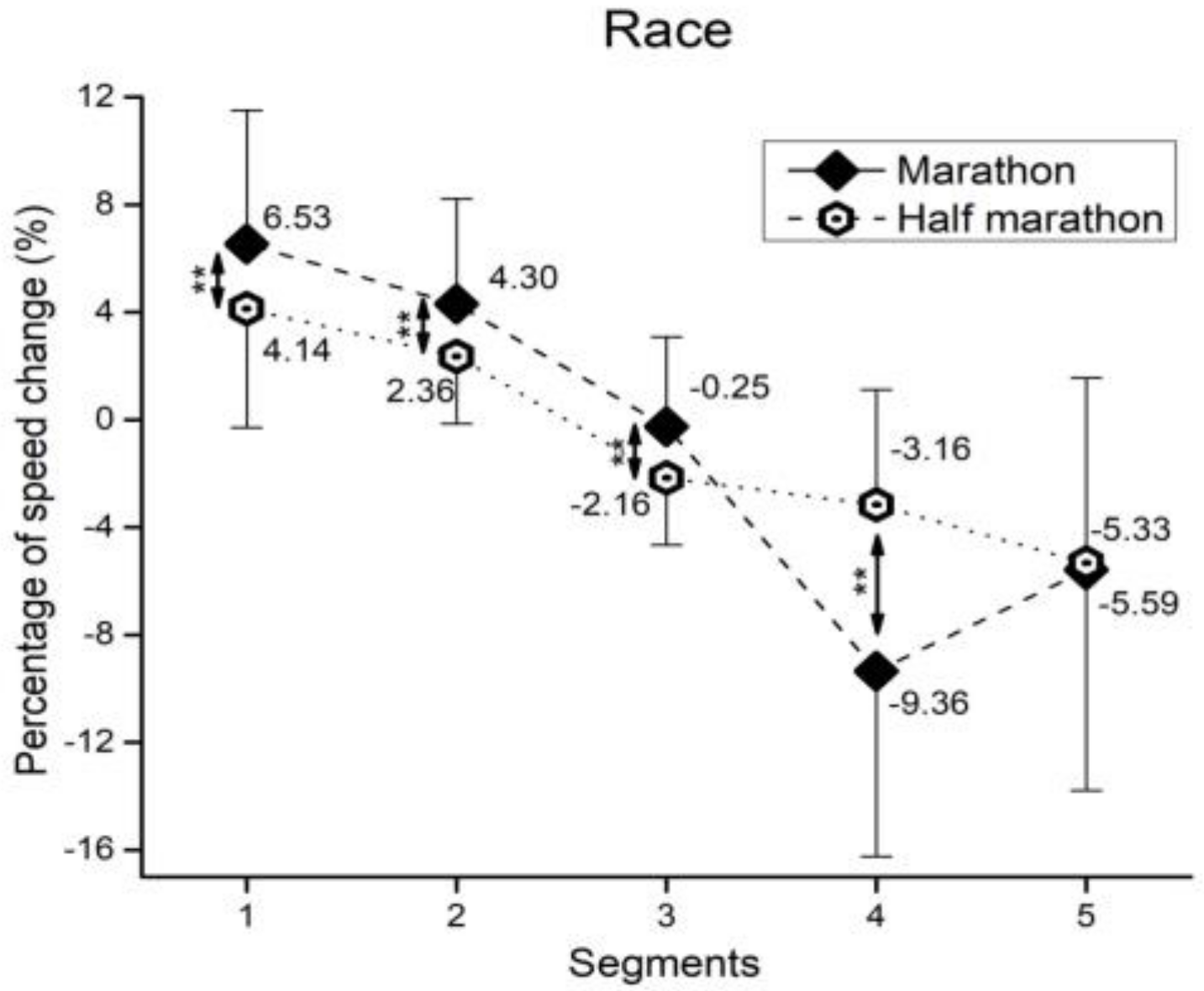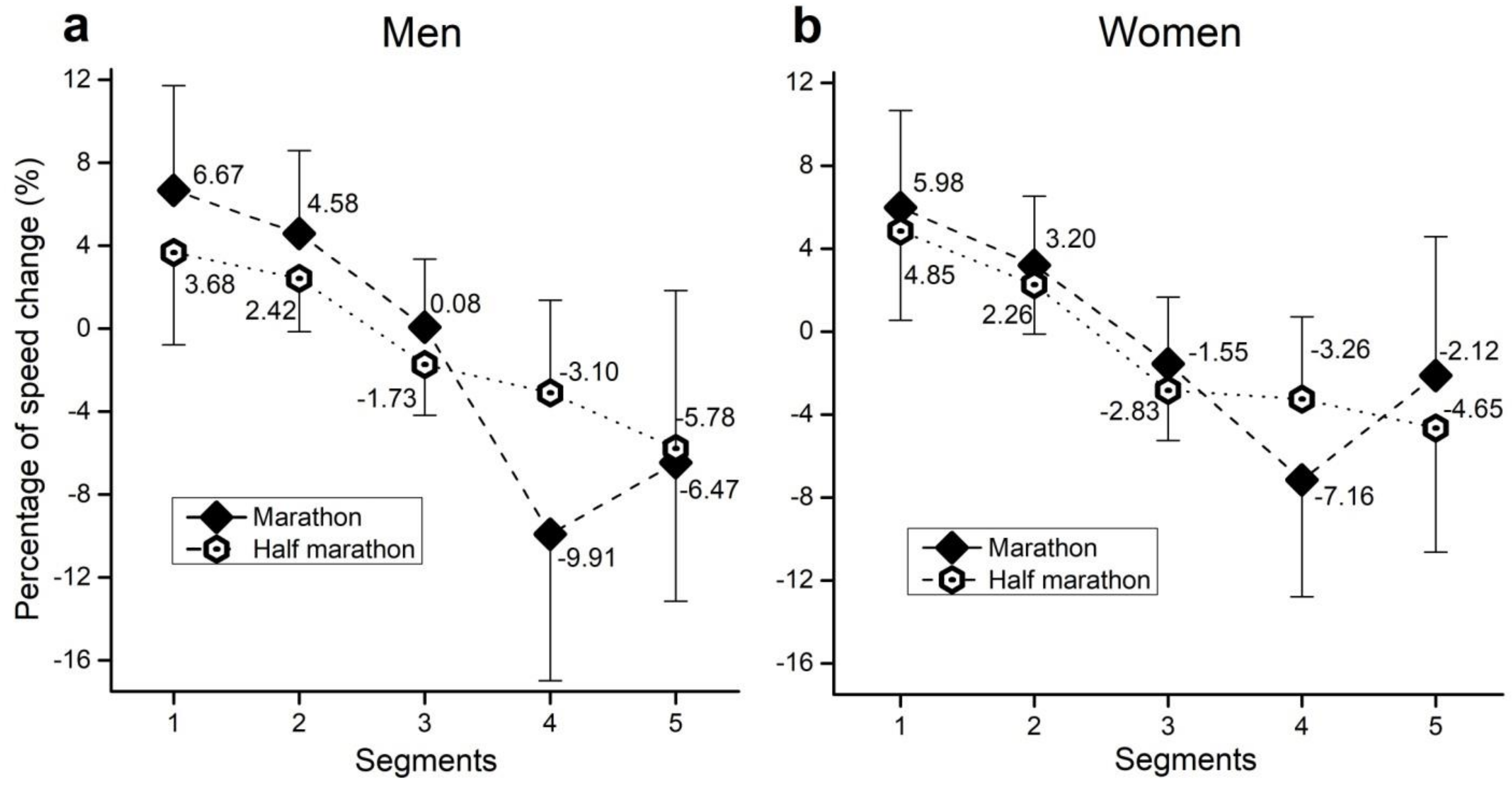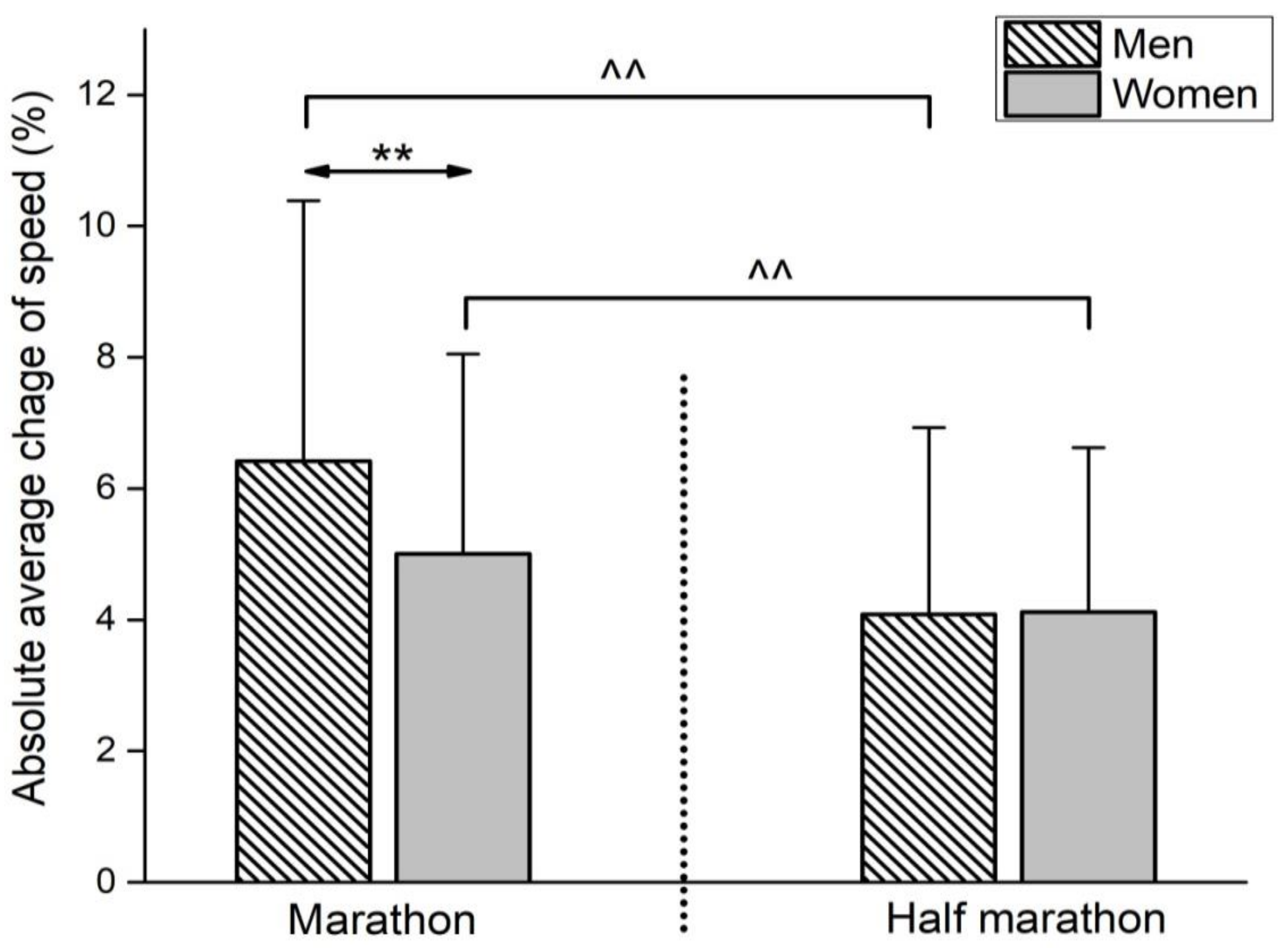Pacing of Women and Men in Half-Marathon and Marathon Races
Abstract
1. Introduction
2. Materials and Methods
2.1. Participants
2.2. Variables and Research Measures
- Segment 1-Average running speed from 0–23.7% of the race (i.e., 0–5 km for half-marathon and 0–10 km for marathon)
- Segment 2-Average running speed from 23.7–47.4% of the race (i.e., 5–10 km for half-marathon and 10–20 km for marathon)
- Segment 3-Average running speed from 47.4–71.1% of the race (i.e., 10–15 km for half-marathon and 20–30 km for marathon)
- Segment 4-Average running speed from 71.1–94.8% of the race (i.e., 15–20 km for half-marathon and 30–40 km for marathon)
- Segment 5-Average running speed from 94.8–100% of the race (i.e., 20–21.0975 km for half-marathon and 40–42.195 km for marathon)
2.3. Process
2.4. Data Analysis
3. Results
4. Discussion
5. Conclusions
Author Contributions
Funding
Acknowledgments
Conflicts of Interest
References
- Knechtle, B.; Nikolaidis, P.T.; Onywera, V.O.; Zingg, M.A.; Rosemann, T.; Rust, C.A. Male and female ethiopian and kenyan runners are the fastest and the youngest in both half and full marathon. SpringerPlus 2016, 5, 223. [Google Scholar] [CrossRef] [PubMed]
- Nikolaidis, P.T.; Knechtle, B. Effect of age and performance on pacing of marathon runners. Open Access J. Sports Med. 2017, 8, 171–180. [Google Scholar] [CrossRef] [PubMed]
- Breen, D.; Norris, M.; Healy, R.; Anderson, R. Marathon pace control in masters athletes. Int. J. Sports Physiol. Perform. 2018, 13, 332–338. [Google Scholar] [CrossRef] [PubMed]
- Hanley, B. Pacing profiles and pack running at the IAAF world half marathon championships. J. Sports Sci. 2015, 33, 1189–1195. [Google Scholar] [CrossRef]
- Knechtle, B.; Nikolaidis, P.T.; Zingg, M.A.; Rosemann, T.; Rust, C.A. Half-marathoners are younger and slower than marathoners. SpringerPlus 2016, 5, 76. [Google Scholar] [CrossRef] [PubMed]
- Abbiss, C.R.; Thompson, K.G.; Lipski, M.; Meyer, T.; Skorski, S. Difference in pacing between time- and distance-based time trials in trained cyclists. Int. J. Sports Physiol. Perform. 2016, 11, 1018–1023. [Google Scholar] [CrossRef] [PubMed]
- Heidenfelder, A.; Rosemann, T.; Rust, C.A.; Knechtle, B. Pacing strategies of ultracyclists in the “race across America”. Int. J. Sports Physiol. Perform. 2016, 11, 319–327. [Google Scholar] [CrossRef]
- Lipinska, P.; Allen, S.V.; Hopkins, W.G. Modeling parameters that characterize pacing of elite female 800-m freestyle swimmers. Eur. J. Sport Sci. 2016, 16, 287–292. [Google Scholar] [CrossRef]
- Lipinska, P.; Allen, S.V.; Hopkins, W.G. Relationships between pacing parameters and performance of elite male 1500-m swimmers. Int. J. Sports Physiol. Perform. 2016, 11, 159–163. [Google Scholar] [CrossRef]
- Wu, S.S.; Peiffer, J.J.; Peeling, P.; Brisswalter, J.; Lau, W.Y.; Nosaka, K.; Abbiss, C.R. Improvement of sprint triathlon performance in trained athletes with positive swim pacing. Int. J. Sports Physiol. Perform. 2016, 11, 1024–1028. [Google Scholar] [CrossRef]
- Konings, M.J.; Hettinga, F.J. Pacing decision making in sport and the effects of interpersonal competition: A critical review. Sports Med. 2018, 48, 1829–1843. [Google Scholar] [CrossRef] [PubMed]
- Micklewright, D.; Parry, D.; Robinson, T.; Deacon, G.; Renfree, A.; St Clair Gibson, A.; Matthews, W.J. Risk perception influences athletic pacing strategy. Med. Sci. Sports Exerc. 2015, 47, 1026–1037. [Google Scholar] [CrossRef]
- Schiphof-Godart, L.; Hettinga, F.J. Passion and pacing in endurance performance. Front. Physiol. 2017, 8, 83. [Google Scholar] [CrossRef] [PubMed]
- Santos-Lozano, A.; Collado, P.S.; Foster, C.; Lucia, A.; Garatachea, N. Influence of sex and level on marathon pacing strategy. Insights from the New York city race. Int. J. Sports Med. 2014, 35, 933–938. [Google Scholar] [CrossRef] [PubMed]
- Nikolaidis, P.T.; Knechtle, B. Do fast older runners pace differently from fast younger runners in the “New York city marathon”? J. Strength Cond. Res. 2017. [Google Scholar] [CrossRef] [PubMed]
- Nikolaidis, P.T.; Knechtle, B. Pacing in age group marathoners in the “New York city marathon”. Res. Sports Med. 2018, 26, 86–99. [Google Scholar] [CrossRef] [PubMed]
- Filipas, L.; Nerli Ballati, E.; Bonato, M.; La Torre, A.; Piacentini, M.F. Elite male and female 800-m runners’ display of different pacing strategies during season-best performances. Int. J. Sports Physiol. Perform. 2018, 13, 1344–1348. [Google Scholar] [CrossRef]
- Deaner, R.O.; Lowen, A. Males and females pace differently in high school cross-country races. J. Strength Cond. Res. 2016, 30, 2991–2997. [Google Scholar] [CrossRef]
- Deaner, R.O.; Addona, V.; Carter, R.E.; Joyner, M.J.; Hunter, S.K. Fast men slow more than fast women in a 10 kilometer road race. PeerJ 2016, 4, e2235. [Google Scholar] [CrossRef]
- March, D.S.; Vanderburgh, P.M.; Titlebaum, P.J.; Hoops, M.L. Age, sex, and finish time as determinants of pacing in the marathon. J. Strength Cond. Res. 2011, 25, 386–391. [Google Scholar] [CrossRef]
- Renfree, A.; Crivoi do Carmo, E.; Martin, L. The influence of performance level, age and gender on pacing strategy during a 100-km ultramarathon. Eur. J. Sport Sci. 2016, 16, 409–415. [Google Scholar] [CrossRef] [PubMed]
- Bertuzzi, R.; Lima-Silva, A.E.; Pires, F.O.; Damasceno, M.V.; Bueno, S.; Pasqua, L.A.; Bishop, D.J. Pacing strategy determinants during a 10-km running time trial: Contributions of perceived effort, physiological, and muscular parameters. J. Strength Cond. Res. 2014, 28, 1688–1696. [Google Scholar] [CrossRef] [PubMed]
- Nikolaidis, P.T.; Knechtle, B. Pacing strategies in the ‘Athens classic marathon’: Physiological and psychological aspects. Front. Physiol. 2018, 9, 1539. [Google Scholar] [CrossRef] [PubMed]
- Diaz, J.J.; Fernandez-Ozcorta, E.J.; Santos-Concejero, J. The influence of pacing strategy on marathon world records. Eur. J. Sport Sci. 2018, 18, 781–786. [Google Scholar] [CrossRef] [PubMed]
- Hanley, B. Pacing, packing and sex-based differences in Olympic and IAAF world championship marathons. J. Sports Sci. 2016, 34, 1675–1681. [Google Scholar] [CrossRef] [PubMed]
- Trubee, N.W.; Vanderburgh, P.M.; Diestelkamp, W.S.; Jackson, K.J. Effects of heat stress and sex on pacing in marathon runners. J. Strength Cond. Res. 2014, 28, 1673–1678. [Google Scholar] [CrossRef] [PubMed]
- Available online: http://vw-ljubljanskimaraton.si (accessed on 15 September 2018).
- Knechtle, B.; Di Gangi, S.; Rust, C.A.; Rosemann, T.; Nikolaidis, P.T. Men’s participation and performance in the ‘Boston marathon’ from 1897 to 2017. Int. J. Sports Med. 2018, 39, 1018–1027. [Google Scholar] [CrossRef] [PubMed]
- Cohen, J. Statistical Power Analysis for the Behavioral Sciences, 2nd ed.; Lawrence Erlbaum Associates: Hillsdale, NJ, USA, 1988. [Google Scholar]
- Abbiss, C.R.; Laursen, P.B. Describing and understanding pacing strategies during athletic competition. Sports Med. 2008, 38, 239–252. [Google Scholar] [CrossRef]
- Faulkner, J.; Parfitt, G.; Eston, R. The rating of perceived exertion during competitive running scales with time. Psychophysiology 2008, 45, 977–985. [Google Scholar] [CrossRef]
- Deaner, R.O.; Carter, R.E.; Joyner, M.J.; Hunter, S.K. Men are more likely than women to slow in the marathon. Med. Sci. Sports Exerc. 2014, 47, 607–616. [Google Scholar] [CrossRef]
- Black, M.I.; Jones, A.M.; Bailey, S.J.; Vanhatalo, A. Self-pacing increases critical power and improves performance during severe-intensity exercise. Appl. Physiol. Nutr. Metab. 2015, 40, 662–670. [Google Scholar] [CrossRef] [PubMed]
- Schallig, W.; Veneman, T.; Noordhof, D.A.; Rodriguez-Marroyo, J.A.; Porcari, J.P.; de Koning, J.J.; Foster, C. The role of the rating-of-perceived-exertion template in pacing. Int. J. Sports Physiol. Perform. 2018, 13, 367–373. [Google Scholar] [CrossRef] [PubMed]
- Tomazini, F.; Pasqua, L.A.; Damasceno, M.V.; Silva-Cavalcante, M.D.; de Oliveira, F.R.; Lima-Silva, A.E.; Bertuzzi, R. Head-to-head running race simulation alters pacing strategy, performance, and mood state. Physiol. Behav. 2015, 149, 39–44. [Google Scholar] [CrossRef] [PubMed]
- Renfree, A.; Casado, A. Athletic races represent complex systems, and pacing behavior should be viewed as an emergent phenomenon. Front. Physiol. 2018, 9, 1432. [Google Scholar] [CrossRef] [PubMed]
- Brick, N.E.; MacIntyre, T.E.; Campbell, M.J. Thinking and action: A cognitive perspective on self-regulation during endurance performance. Front. Physiol. 2016, 7, 159. [Google Scholar] [CrossRef]
- Knechtle, B.; Nikolaidis, P.T. Sex- and age-related differences in half-marathon performance and competitiveness in the world’s largest half-marathon-The goteborgsvarvet. Res. Sports Med. 2018, 26, 75–85. [Google Scholar] [CrossRef]
- Salinero, J.J.; Soriano, M.L.; Lara, B.; Gallo-Salazar, C.; Areces, F.; Ruiz-Vicente, D.; Abian-Vicen, J.; Gonzalez-Millan, C.; Del Coso, J. Predicting race time in male amateur marathon runners. J. Sports Med. Phys. Fit. 2017, 57, 1169–1177. [Google Scholar]



| Segment 1 Speed (m/s) | Segment 2 Speed (m/s) | Segment 3 Speed (m/s) | Segment 4 Speed (m/s) | Segment 5 Speed (m/s) | Average Race Speed (m/s) | ||
|---|---|---|---|---|---|---|---|
| Men 42.2 km N = 1478 | Median | 3.24 | 3.18 | 3.06 | 2.80 | 2.88 | 3.04 |
| Mean | 3.29 | 3.22 | 3.09 | 2.82 | 2.91 | 3.08 | |
| SD | 0.44 | 0.45 | 0.49 | 0.52 | 0.49 | 0.46 | |
| CV | 0.13 | 0.14 | 0.16 | 0.18 | 0.17 | 0.15 | |
| Women 42.2 km N = 375 | Median | 2.96 | 2.90 | 2.78 | 2.63 | 2.77 | 2.80 |
| Mean | 3.04 | 2.95 | 2.82 | 2.68 | 2.81 | 2.86 | |
| SD | 0.36 | 0.38 | 0.43 | 0.44 | 0.41 | 0.39 | |
| CV | 0.12 | 0.13 | 0.15 | 0.16 | 0.15 | 0.14 | |
| Men 21.1 km N = 4406 | Median | 3.21 | 3.18 | 3.06 | 3.04 | 2.97 | 3.10 |
| Mean | 3.26 | 3.22 | 3.09 | 3.06 | 2.99 | 3.14 | |
| SD | 0.44 | 0.44 | 0.46 | 0.49 | 0.50 | 0.45 | |
| CV | 0.14 | 0.14 | 0.15 | 0.16 | 0.17 | 0.14 | |
| Women 21.1 km N = 2852 | Median | 2.90 | 2.83 | 2.69 | 2.69 | 2.64 | 2.76 |
| Mean | 2.91 | 2.83 | 2.70 | 2.69 | 2.66 | 2.77 | |
| SD | 0.32 | 0.35 | 0.36 | 0.39 | 0.39 | 0.35 | |
| CV | 0.11 | 0.12 | 0.14 | 0.14 | 0.15 | 0.13 |
© 2019 by the authors. Licensee MDPI, Basel, Switzerland. This article is an open access article distributed under the terms and conditions of the Creative Commons Attribution (CC BY) license (http://creativecommons.org/licenses/by/4.0/).
Share and Cite
Nikolaidis, P.T.; Ćuk, I.; Knechtle, B. Pacing of Women and Men in Half-Marathon and Marathon Races. Medicina 2019, 55, 14. https://doi.org/10.3390/medicina55010014
Nikolaidis PT, Ćuk I, Knechtle B. Pacing of Women and Men in Half-Marathon and Marathon Races. Medicina. 2019; 55(1):14. https://doi.org/10.3390/medicina55010014
Chicago/Turabian StyleNikolaidis, Pantelis T., Ivan Ćuk, and Beat Knechtle. 2019. "Pacing of Women and Men in Half-Marathon and Marathon Races" Medicina 55, no. 1: 14. https://doi.org/10.3390/medicina55010014
APA StyleNikolaidis, P. T., Ćuk, I., & Knechtle, B. (2019). Pacing of Women and Men in Half-Marathon and Marathon Races. Medicina, 55(1), 14. https://doi.org/10.3390/medicina55010014







